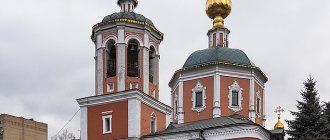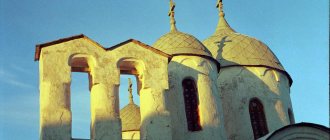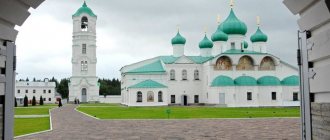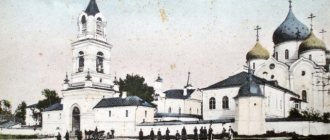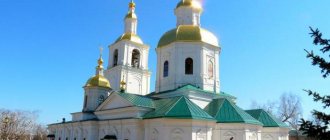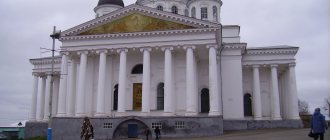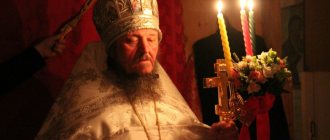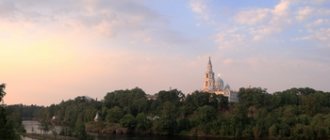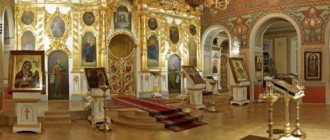Mir
Russia Moscow Moscow Metochion of the Valaam Monastery Map loading in progress...
{"format":"leaflet","minzoom":false,"maxzoom":false,"limit":50,"offset":0,"link":"all","sort":[""], "order":[],"headers":"show","mainlabel":"","intro":"","outro":"","searchlabel":"\u2026 \u0441\u043b\u0435\ u0434\u0443\u044e\u0449\u0438\u0435 \u0440\u0435\u0437\u0443\u043b\u044c\u0442\u0430\u0442\u044b","default":"","import-annotation":false,"width ":"auto","height":"350px","centre":{"text":"","title":"""link":"""lat":55.7749730000000027985151973553001880645751953125,"lon": 37.5894550000000009504219633527100086212158203125,"icon":""},"title":"","label":"","icon":"","lines":[],"polygons":[],"circles":[ ],"rectangles":[],"copycoords":false,"static":false,"zoom":8,"defzoom":14,"layers":["OpenStreetMap"],"image layers":[] ,"overlays":[],"resizable":false,"fullscreen":true,"scrollwheelzoom":true,"cluster":false,"clustermaxzoom":9,"clusterzoomonclick":true,"clustermaxradius":80, "clusterspiderfy":true,"geojson":"","clicktarget":"","showtitle":true,"hidenamespace":false,"template":"","userparam":"","activeicon": "","pagelabel":false,"ajaxcoordproperty":"","ajaxquery":"","locations":[{"text":"\u003Cb\u003E\u003Ca href=\"/palomnik/%D0% 9C%D0%BE%D1%81%D0%BA%D0%BE%D0%B2%D1%81%D0%BA%D0%BE%D0%B5_%D0%BF%D0%BE%D0%B4% D0%B2%D0%BE%D1%80%D1%8C%D0%B5_%D0%92%D0%B0%D0%BB%D0%B0%D0%B0%D0%BC%D1%81%D0% BA%D0%BE%D0%B3%D0%BE_%D0%BC%D0%BE%D0%BD%D0%B0%D1%81%D1%82%D1%8B%D1%80%D1%8F\ » title=\»\u041c\u043e\u0441\u043a\u043e\u0432\u0441\u043a\u043e\u0435 \u043f\u043e\u0434\u0432\u043e\u0440\u044c\u0435 \u0412\u 0430\u043b\u0430\ u0430\u043c\u0441\u043a\u043e\u0433\u043e\u043c\u043e\u043d\u0430\u0441\u0442\u044b\u0440\u044f\u003E\u041c\u043e\u0441\u 043a\u043e\u0432\u0441\ u043a\u043e\u0435 \u043f\u043e\u0434\u0432\u043e\u0440\u044c\u0435 \u0412\u0430\u043b\u0430\u0430\u043c\u0441\u043a\u043e\u0 433\u043e\u043c\u043e\u043d\ u0430\u0441\u0442\u044b\u0440\u044f\u003C/a\u003E\u003C/b\u003E\u003Chr /\u003E\u003Ca href=\»/palomnik/%D0%A1%D0%B2%D0%BE% D0%B9%D1%81%D1%82%D0%B2%D0%BE:%D0%90%D0%BD%D0%BD%D0%BE%D1%82%D0%B0%D1%86%D0 %B8%D1%8F\" title=\"\u0421\u0432\u043e\u0439\u0441\u0442\u0432\u043e:\u0410\u043d\u043d\u043e\u0442\u0430\u0446\u0438\u044f\"\ u003E\u0410\u043d\u043d\u043e\u0442\u0430\u0446\u0438\u044f\u003C/a\u003E: "'\u041c\u043e\u0441\u043a\u043e\u0432\u0441\u043 a\u043e\u0435\u043f \u043e\u0434\u0432\u043e\u0440\u044c\u0435 \u0412\u0430\u043b\u0430\u0430\u043c\u0441\u043a\u043e\u0433\u043e \u043c\u043e\ u043d\u0430\u0441\u0442\u044b "" "" 440\u0435\u043f\u043e\u0434 \u043e\u0431\u043d\u044b\u0445 \u0421\u0435\u0440\u0433\u0438\u044f \u0438 \u0413\u0435\u0440\u043c\u0430\u043d\u0430 \u041 2\u0430\u043b\u0430\u0430\u043c """title":" \u041c\u043e \u0441\u043a\u043e\u0432\u0441\u043a\u043e\u0435 \u043f\u043e\u0434\u0432\u043e\u0440\u044c\u0435 \u0412\u0430\u043b\u0430\ u0430\u043c\u0441\u043a\u043e "link":""lat":55.774973000000002798515197355300188064575195 3125,"lon":37.5894550000000009504219633527100086212158203125,"icon":""} ],"imageLayers":[]}
55.774973; 37.589455
Russia, Moscow, 2nd Tverskaya-Yamskaya street, 52
Moscow
Russia
Telephone:
+7 (499) 972-86-10
Telephone:
+7 (499)-251-06-70
Moscow courtyard of the Valaam Monastery
founded at the Church of St. Sergius and Herman of Valaam, built in 1901-1904.
Content
- 1. History
- 2 Temples 2.1 Temple of St. Sergius and Herman of Valaam
- 2.2 Lower Temple of the Holy Blessed Prince Alexander Nevsky
- 2.3 Church of St. Nicholas of Myra at the Research Institute of Neurosurgery named after. N.N. Burdenko
- 2.4 Hospital church in the name of the icon of the Mother of God “Healer” at a separate unit of the State Budgetary Healthcare Institution City Clinical Hospital No. 40 Clinic
- 2.5 Hospital church in honor of the icon of the Mother of God “Vsetsaritsa” at the 2nd Central Clinical Hospital named after. ON THE. Semashko JSC Russian Railways, Moscow
- 2.6 Skete in honor of the Icon of the Mother of God “Valaam”
History[edit]
The history of the construction of the Moscow courtyard of the Spaso-Preobrazhensky Valaam Monastery began in May 1862. More than seventy eminent Muscovites offered to use their funds to build a monastery chapel with premises for monastics in the capital city of Moscow. And only on July 27, 1900, the abbot, Abbot Gabriel, and the brethren laid the foundation for the monastery.
Archimandrite Gabriel (Gavrilov Georgy Gavrilovich) was born in the Ryazan province. After graduating from the rural zemstvo school, he entered the Spaso-Preobrazhensky Valaam Monastery, where he was tonsured a monk in 1880.
In 1881 he was elected abbot of the monastery and elevated to the rank of abbot. With the blessing of Abbot Gabriel, the construction of the courtyard of the Valaam Monastery began in Moscow, a two-story building was built (1901), the main altar in the name of St. Sergius and Herman and the right chapel in honor of the Jerusalem Icon of the Mother of God were consecrated.
In 1903, Abbot Gabriel was appointed rector of the Holy Trinity Alatyr Monastery of the Simbirsk Diocese with elevation to the rank of archimandrite. In December 1910, the archimandrite fell ill with pneumonia and soon departed to the Lord. Buried Fr. Gabriel at the altar of the Trinity Cathedral of the Alatyr Monastery.
2,Georgy Ivanovich Kurnikov is often mentioned among the philanthropists. He came from the Uglichesky district of the Yaroslavl province. Being a merchant, he was engaged in trade, built houses, and rented them out. A fair share of the capital went to charitable purposes. Georgy Ivanovich contributed large sums to the needs of the city.
He also participated in church affairs, providing all possible financial support. At the Church of St. Basil of Caesarea in the Tverskaya-Yamskaya Sloboda (the temple was demolished in the 30s), he served as headman and ktitor until his death in 1918. Georgy Ivanovich was married to Praskovya Yakovlevna Veselova, who also belonged to a famous merchant family.
Georgiy Kournikov and his brother Philip donated a large amount of funds, as well as a list of the Icon of the Mother of God “Jerusalem”, which to this day is kept in one of the churches of the Valaam Monastery.
Life in the monastery courtyard was subject to strict monastic rules. The order of services was determined by Abbot Gabriel (†1848-1910): “In the chapel at 8 o’clock in the morning on school days, a short prayer service was held for the children of students, who at this time come in large numbers to pray before teaching” (entry from Father Gabriel’s personal diary) .
Spiritual and educational activities at the farmstead are carried out actively, especially in recent years. After more than 100 years, the traditions laid down in pre-revolutionary times are still maintained today. Patriarch Kirill’s position on the need for spiritual and moral education is clearly observed in the courtyard: “The most important aspect of the activities of Sunday schools is introducing people to Christ, strengthening them in faith and a godly life, and instructing them in the law of the Lord. Parochial schools should not turn into mere places for leisure; one must always remember that their main task is to lead a person to God and contribute to his spiritual growth.”
In support of this statement, an entire educational structure has been organized at the compound. These include Sunday schools for children and adults, a theological lecture hall, and an open-air cinema. Another important aspect of the educational activities of the metochion is conversations between parishioners and the priest. This format of open communication helps to unite the parish, determine the prevailing interests and aspirations in the community, and direct them in a direction that will contribute to both the spiritual and quantitative growth of the community itself and the intensification of its social and missionary activities. At the Moscow courtyard of the Valaam Monastery, full-time priests regularly conduct conversations for parishioners and guests of the temple. From time to time, well-known ministers and teachers of theological schools who are respected by believers are invited to conduct conversations.
After 1917, the inhabitants and parishioners of the Valaam metochion, together with all of Orthodox Russia, drank in full the cup of mockery and persecution. The majestic building of the courtyard was mutilated: the cross was removed from the dome, the belfry was broken. The dome was covered with logs, the floor was filled with a thick layer of concrete, the entrance to the chapel and many of the windows were walled up.
However, despite such a difficult and troubled time, the parishioners called their beloved courtyard “the only haven, a quiet refuge from storms, the door to heaven,” and when they learned that the brethren were going to return to the monastery, they fervently asked the abbot of the Valaam Monastery to leave them in Moscow. His Holiness Patriarch Tikhon, celebrating the Divine Liturgy in the Church of St. Sergius and Herman of Valaam shortly before his imprisonment, called the brethren of the monastery “a stronghold, a pillar of Orthodoxy and a seedbed of faith in the Mother See of the Kingdom of Russia” and expressed confidence that “the brethren of the monastery will remain a consolation to all who mourn until the end and burdened."
On April 2, 1922, 5 poods and 22 pounds of silver church utensils were confiscated from the church “for the hungry of the Volga region.” In the same year, despite the intervention of the Finnish authorities, the top floor of the building was allocated as premises for the so-called “social women”. All this created incredible inconvenience and embarrassment for the monastic brethren, both because of such an undesirable element installed in the monastic premises, and because of inevitable clashes with the communists. Nevertheless, the monastic brethren firmly continued their service to the Lord, opposing not only the Bolsheviks, but also the renovationists.
The unbearable living conditions and searches did not break the remaining inhabitants. A few days before the closure of the monastery, the Bolsheviks, accompanied by Red Army soldiers, unexpectedly descended on the monastery at night and carried out a thorough search of the brethren’s premises. However, they found nothing and left with nothing.
On the feast of the Kazan Icon of the Mother of God, in the morning before the liturgy itself, they raided the courtyard a second time, this time with the goal of closing it and evicting the brethren. At this time there were many parishioners in the church, and this circumstance forced the Bolsheviks to postpone their evil intention until the end of the service. The proposal made to the brethren to “carry their belongings out onto the cars” was refused. Then the police themselves began to take out the things and, loading them into cars, sent them to the Pokrovsky Monastery. On October 22, 1924, the Valaam courtyard was closed.
In a letter dated June 14/27, 1923 to the head of the metochion, Hieromonk Galaktion, Father Abbot Pavlin insisted on the speedy departure of part of the brethren. Father Abbot seemed to have foreseen the consequences of the policies pursued by the new government; in his letter he warned the brethren: “Do not rely on the fact that the period of your stay in the courtyard has been extended, for you cannot rely on those who persecute the Church of Christ.
In all likelihood, the extension of this period is a mere accident.” By decree of the monastery council, part of the brethren, having received visas to travel to Finland, returned to the monastery. The remaining brethren were strictly “charged with obedience and the indispensable duty of being unquestioning in obedience and obedience to the head of the metochion, Hieromonk Galaktion, and strictly observing the rules, regulations and pious customs of the holy monastery.”
Yet services continued, as the churchyard church remained under the jurisdiction of the local parish council. Due to the lack of a place to live and due to such a hostile attitude of the Bolsheviks towards the monastics, part of the brethren filed a petition for permission to return back to Valaam. After various ordeals, permission was finally given, and 18 brethren returned to the monastery on December 19, 1924. The remaining 16 people remained in Moscow to conduct worship in the church of St. Sergius and Herman, the Wonderworkers of Valaam, settling in the basement, opposite their courtyard, which was captured by the Bolsheviks.
The temple was finally closed in 1926, the inhabitants were dispersed and partially arrested. However, the holy monks, fulfilling the blessing of His Holiness Patriarch Tikhon, did not abandon their flock: they served in the Church of Our Lady of Rzhev on Povarskaya until its closure. The majestic building of the courtyard was mutilated: the cross was removed from the dome, the belfry was broken. The dome was covered with logs, the floor of Metlakh tiles was filled with a thick layer of concrete, the entrance to the chapel and many of the windows were walled up.
Later, clinic No. 36 of the Frunzensky district of Moscow was located here, converted into a hospital during War 1. In 1944-1945, several brilliant operations were performed here by the world-famous surgeon St. Luke (Voino-Yasenetsky), who came to the Local Council and meetings of the Holy Synod.
By the early nineties, the building fell into disrepair, communications were not working, and the question of its demolition was raised. On April 1, 1993, the metochion was finally returned to the Church, and monastic life resumed. After the installation of a temporary iconostasis in the lower church (former chapel), the first Divine Liturgy was celebrated on August 1, 1993. New residents and parishioners came here. The small lower temple was overcrowded. And by the spring of the next year, the central part of the temple in the name of St. Sergius and Herman of Valaam was cleared, and on May 1, 1994, the first Easter service was held there. Since then, a lot has changed in the courtyard. On October 25, 1996, on the day of the celebration of the Icon of the Mother of God “Jerusalem,” the first service was held in the newly opened aisle of the upper church, consecrated in honor of this icon. With the help of benefactors, the belfry was restored, and on Maundy Thursday 1997, the bells rang again for the first time in many decades.
Soon the restoration of the lower church began, a new iconostasis was installed, and the previous painting and interior were largely restored. With the blessing of His Holiness Patriarch Alexy II of Moscow and All Rus', the temple was named in honor of the holy noble prince Alexander Nevsky. The first service was held here on December 6, 1998, on the day of remembrance of the holy prince.
The repeatedly painted over marvelous paintings of the main staircase and the upper church are being painstakingly cleared away.
In 1998, a new copy of the Valaam Icon of the Mother of God was written for the Moscow Metochion. This revered icon in an icon case with a carved canopy and with numerous gifts is located on the northern column of the upper temple. This list is miraculous. It is significant that miracles from him began simultaneously with the pan-church glorification of the Valaam image.
On the southern column of the temple in the name of St. Sergius and Herman there is a beautiful image of the Valaam wonderworkers, patrons of the Moscow courtyard.
Moscow metochion of the Valaam Monastery, metochion of the stauropegial monastery
On October 18, 1901, Metropolitan of Moscow and Kolomna Vladimir (Epiphany) consecrated a temple in honor of the Venerable Sergius and Herman, Valaam wonderworkers. The majestic building, designed by the famous architect A. N. Roop, adorned a corner of Moscow at the intersection of 2nd Tverskaya-Yamskaya Street and Alexander Nevsky Lane. The gray granite foundation, dark red polished columns, and window sills in the chapel and temple were carved from granite and marble by the labors of the Valaam brethren. According to the recollections of parishioners, “the bright church with an airy dome and choirs, designed for more than a thousand people, filled the soul with special solemnity.” The majestic iconostasis of the upper church with gilded carvings was made in Valaam, the icons for the iconostasis were painted by the artist V.P. Guryanov. Benefactors donated valuable silver utensils and vestments.
From the diary of Abbot Gabriel: “On the 2nd day after the consecration of the chapel, October 22, the day of the Kazan Mother of God, I performed a solemn Divine service in a cathedral service, on the eve of the all-night vigil and the very day of the holiday, Liturgy and prayer service with many years for the Authorities, benefactors and builders, who were diligent and labored in the creation of this temple. Such was my desire to pray after the consecration of the temple and to make a bloodless sacrifice for everyone and for everything, which was done to help God. Upon completion of all work on the construction of the courtyard, a commemorative photograph."
Hegumen Gabriel
Read more "
Georgy Ivanovich Kurnikov is often mentioned among the philanthropists. He came from the Uglich district of the Yaroslavl province. Being a merchant, he was engaged in trade, built houses, and rented them out. A fair share of the capital went to charitable purposes. Georgy Ivanovich contributed large sums to the needs of the city.
He also participated in church affairs, providing all possible financial support. At the Church of St. Basil of Caesarea in the Tverskaya-Yamskaya Sloboda (the temple was demolished in the 30s), he served as headman and ktitor until his death in 1918. Georgy Ivanovich was married to Praskovya Yakovlevna Veselova, who also belonged to a famous merchant family.
Georgiy Kournikov and his brother Philip donated a large amount of funds, as well as a list of the Icon of the Mother of God “Jerusalem”, which to this day is kept in one of the churches of the Valaam Monastery.
Life in the monastery courtyard was subject to strict monastic rules. The order of services was determined by Abbot Gabriel (†1848-1910): “In the chapel at 8 o’clock in the morning on school days, a short prayer service was held for the children of students, who at this time come in large numbers to pray before teaching” (entry from Father Gabriel’s personal diary) . Apparently, Abbot Gabriel is pictured with such students.
Spiritual and educational activities at the farmstead are carried out actively, especially in recent years. After more than 100 years, the traditions laid down in pre-revolutionary times are still maintained today. Patriarch Kirill’s position on the need for spiritual and moral education is clearly observed in the courtyard: “The most important aspect of the activities of Sunday schools is introducing people to Christ, strengthening them in faith and a godly life, and instructing them in the law of the Lord. Parochial schools should not turn into mere places for leisure; one must always remember that their main task is to lead a person to God and contribute to his spiritual growth.”
In support of this statement, an entire educational structure has been organized at the compound. These include Sunday schools for children and adults, a theological lecture hall, and an open-air cinema. Another important aspect of the educational activities of the metochion is conversations between parishioners and the priest. This format of open communication helps to unite the parish, determine the prevailing interests and aspirations in the community, and direct them in a direction that will contribute to both the spiritual and quantitative growth of the community itself and the intensification of its social and missionary activities. At the Moscow courtyard of the Valaam Monastery, full-time priests regularly conduct conversations for parishioners and guests of the temple. From time to time, well-known ministers and teachers of theological schools who are respected by believers are invited to conduct conversations.
After 1917, the inhabitants and parishioners of the Valaam metochion, together with all of Orthodox Russia, drank in full the cup of mockery and persecution. The majestic building of the courtyard was mutilated: the cross was removed from the dome, the belfry was broken. The dome was covered with logs, the floor was filled with a thick layer of concrete, the entrance to the chapel and many of the windows were walled up.
However, despite such a difficult and troubled time, the parishioners called their beloved courtyard “the only haven, a quiet refuge from storms, the door to heaven,” and when they learned that the brethren were going to return to the monastery, they fervently asked the abbot of the Valaam Monastery to leave them in Moscow. His Holiness Patriarch Tikhon, celebrating the Divine Liturgy in the Church of St. Sergius and Herman of Valaam shortly before his imprisonment, called the brethren of the monastery “a stronghold, a pillar of Orthodoxy and a seedbed of faith in the Mother See of the Kingdom of Russia” and expressed confidence that “the brethren of the monastery will remain a consolation to all who mourn until the end and burdened."
On April 2, 1922, 5 poods and 22 pounds of silver church utensils were confiscated from the church “for the hungry of the Volga region.” In the same year, despite the intervention of the Finnish authorities, the top floor of the building was allocated as premises for the so-called “social women”. All this created incredible inconvenience and embarrassment for the monastic brethren, both because of such an undesirable element installed in the monastic premises, and because of inevitable clashes with the communists. Nevertheless, the monastic brethren firmly continued their service to the Lord, opposing not only the Bolsheviks, but also the renovationists.
The unbearable living conditions and searches did not break the remaining inhabitants. A few days before the closure of the monastery, the Bolsheviks, accompanied by Red Army soldiers, unexpectedly descended on the monastery at night and carried out a thorough search of the brethren’s premises. However, they found nothing and left with nothing.
On the feast of the Kazan Icon of the Mother of God, in the morning before the liturgy itself, they raided the courtyard a second time, this time with the goal of closing it and evicting the brethren. At this time there were many parishioners in the church, and this circumstance forced the Bolsheviks to postpone their evil intention until the end of the service. The proposal made to the brethren to “carry their belongings out onto the cars” was refused. Then the police themselves began to take out the things and, loading them into cars, sent them to the Pokrovsky Monastery. On October 22, 1924, the Valaam courtyard was closed.
In a letter dated June 14/27, 1923 to the head of the metochion, Hieromonk Galaktion, Father Abbot Pavlin insisted on the speedy departure of part of the brethren. Father Abbot seemed to have foreseen the consequences of the policies pursued by the new government; in his letter he warned the brethren: “Do not rely on the fact that the period of your stay in the courtyard has been extended, for you cannot rely on those who persecute the Church of Christ. In all likelihood, the extension of this period is a mere accident.” By decree of the monastery council, part of the brethren, having received visas to travel to Finland, returned to the monastery. The remaining brethren were strictly “charged with obedience and the indispensable duty of being unquestioning in obedience and obedience to the head of the metochion, Hieromonk Galaktion, and strictly observing the rules, regulations and pious customs of the holy monastery.” Yet services continued, as the churchyard church remained under the jurisdiction of the local parish council. Due to the lack of a place to live and due to such a hostile attitude of the Bolsheviks towards the monastics, part of the brethren filed a petition for permission to return back to Valaam. After various ordeals, permission was finally given, and 18 brethren returned to the monastery on December 19, 1924. The remaining 16 people remained in Moscow to conduct worship in the church of St. Sergius and Herman, the Wonderworkers of Valaam, settling in the basement, opposite their courtyard, which was captured by the Bolsheviks.
The temple was finally closed in 1926, the inhabitants were dispersed and partially arrested. However, the holy monks, fulfilling the blessing of His Holiness Patriarch Tikhon, did not abandon their flock: they served in the Church of Our Lady of Rzhev on Povarskaya until its closure. The majestic building of the courtyard was mutilated: the cross was removed from the dome, the belfry was broken. The dome was covered with logs, the floor of Metlakh tiles was filled with a thick layer of concrete, the entrance to the chapel and many of the windows were walled up.
Later, clinic No. 36 of the Frunzensky district of Moscow was located here, converted into a hospital during the war. In 1944-1945, several brilliant operations were performed here by the world-famous surgeon St. Luke (Voino-Yasenetsky), who came to the Local Council and meetings of the Holy Synod. By the early nineties, the building fell into disrepair, communications were not working, and the question of its demolition was raised. On April 1, 1993, the metochion was finally returned to the Church, and monastic life resumed. After the installation of a temporary iconostasis in the lower church (former chapel), the first Divine Liturgy was celebrated on August 1, 1993. New residents and parishioners came here. The small lower temple was overcrowded. And by the spring of the next year, the central part of the temple in the name of St. Sergius and Herman of Valaam was cleared, and on May 1, 1994, the first Easter service was held there. Since then, a lot has changed in the courtyard. On October 25, 1996, on the day of the celebration of the Icon of the Mother of God “Jerusalem,” the first service was held in the newly opened aisle of the upper church, consecrated in honor of this icon. With the help of benefactors, the belfry was restored, and on Maundy Thursday 1997, the bells rang again for the first time in many decades. Soon the restoration of the lower church began, a new iconostasis was installed, and the previous painting and interior were largely restored. With the blessing of His Holiness Patriarch Alexy II of Moscow and All Rus', the temple was named in honor of the holy noble prince Alexander Nevsky. The first service was held here on December 6, 1998, on the day of remembrance of the holy prince. The repeatedly painted over marvelous paintings of the main staircase and the upper church are being painstakingly cleared away. In 1998, a new copy of the Valaam Icon of the Mother of God was written for the Moscow Metochion. This revered icon in an icon case with a carved canopy and with numerous gifts is located on the northern column of the upper temple. This list is miraculous. It is significant that miracles from him began simultaneously with the pan-church glorification of the Valaam image. On the southern column of the temple in the name of St. Sergius and Herman there is a beautiful image of the Valaam wonderworkers, patrons of the Moscow courtyard.
On Sundays after the Divine Liturgy, akathists to the Valaam Icon of the Mother of God and the Great Martyr are read. Panteleimon.
Temples[edit]
Temple of Saints Sergius and Herman of Valaam[edit]
Interior decoration of the temple
The building of the Moscow courtyard of the Valaam Monastery was built in 1901.
A chapel was built on the first floor of the building, and a two-altar church on the second floor. Architect A.I. Roop.
The central altar was consecrated on October 18, 1901 in the name of the Venerable Sergius and Herman of Valaam by Metropolitan Vladimir (Epiphany) of Moscow and Kolomna, the side chapel was consecrated in honor of the Jerusalem Icon of the Mother of God.
During the years of persecution, the community of the metochion was deregistered, and the building was closed and transferred to the national economy in 1926.
In 1992, the former courtyard building was returned to the Valaam Monastery, but was vacated only the following year.
In the chapel on the ground floor, with the blessing of His Holiness Patriarch Alexy II, a temple was built in the name of the Holy Blessed Grand Duke Alexander Nevsky.
Lower Temple of the Holy Blessed Prince Alexander Nevsky[edit]
Currently under restoration
Church of St. Nicholas of Myra at the Research Institute of Neurosurgery named after. N.N. Burdenko[edit]
Shrines:
revered icon of the Great Martyr. Panteleimon and a particle of the relics of the holy saint. Elizabeth.
Address:
125047 Moscow, st. 4th Tverskaya-Yamskaya, 16
Telephone:
+7 (499) 972-86-10
Hospital church in the name of the icon of the Mother of God “Healer” at a separate unit of the State Budgetary Healthcare Institution City Clinical Hospital No. 40 Clinic[edit]
Shrines:
ark with the relics of St. prpp. Herman of Alaska, Antipas of Valaam, John the Long-Suffering of Pechersk; St. Innocent of Moscow; St. mchch. Infants of Bethlehem; Valaam righteous hermit schemamonk Nikolai (Smelov); part of the custodium (wax seal) of the Edicule of the Resurrection of Christ.
Address:
129128 Moscow, st. Malakhitovaya, 16
Hospital church in honor of the icon of the Mother of God “Vsetsaritsa” at the 2nd Central Clinical Hospital named after. ON THE. Semashko JSC Russian Railways, Moscow[edit]
Shrines:
the icon of the Mother of God “The Tsarina of All”, painted on Mount Athos; reliquary with the relics of saints: Lazarus the Fourth Day, Bishop of Kitia; prpp. Herman of Alaska, Antipas of Valaam, Arseny Konevsky; St. Innocent of Moscow; mchch. Infants of Bethlehem; part of the vestment of St. John of Shanghai and San Francisco, a piece of the Oak of Mamre, the stone of the Holy Sepulcher.
Address:
129128 Moscow, st. Budaiskaya, 2
Skete in honor of the Valaam Icon of the Mother of God[edit]
Shrines:
particles of the relics of saints. Zverinetsky, Rev. Kuksha of Odessa, St. Jonah of Kyiv, St. Luka Krymsky; revered icons of the Mother of God “Valaam”, holy Royal Martyrs.
Skete address
: 140473 Moscow region, Kolomensky district, Bortnikovo village
Login to the site
The Valaam Monastery is surrounded by the waters of Lake Ladoga and is not always accessible to pilgrims. When navigation ends, helicopters maintain communication with our “northern Athos”. And at the same time, Valaam is always close to us. In the thick of the city bustle, at the intersection of Staro-Peterhofsky and Narvsky Avenues, there is the courtyard of the Valaam Spaso-Preobrazhensky Monastery and with it the Church of the Kazan Icon of the Mother of God. Legally and in spirit, it is an integral part of the island monastery. But city “registration” gives the life of the farmstead and its community its own special specificity.
Author: Elena Milovidova, Photographer: Andrey Petrov.
Compound today
“You come and it’s as if you find yourself in another world,” parishioners say about the appearance of the courtyard. The Church of the Kazan Icon of the Mother of God pleases the eye with its façade decor and large stained glass windows. During the Soviet years it was a department store, then a furniture factory. The vaults inside still contain traces of reinforced concrete floors. To restore the farmstead, recognized as an object of cultural heritage of federal significance, a technical supervision service was organized here. Its director, Honored Builder of the Russian Federation, Lyudmila Solovyova, is monitoring the progress of the restoration. All work here is carried out professionally and with great love. It would seem that it doesn’t matter what kind of shops are in the temple? In the courtyard there are beautiful wooden benches. The temple also has its own architect - parishioner Yulia Trukshina. Among her latest major works is the design of an oak carved iconostasis for the courtyard, which was made in Greece. Today, all communications of the Valaam Monastery are carried out through the courtyard: accounting, a lawyer, supply and transport services, and a branch of the pilgrimage service are located here. The courtyard is the legal address of the monastery. In addition to the Kazan Church, bell tower, abbot and cell buildings, the chapel of the New Martyrs and Confessors of Russia is consecrated here, a convenient baptistery for baptism by full immersion is equipped, and there is a large icon and bookstore. “Black and white” clergy Of the thirteen clergy of the metochion, four - Father Alexander Tochilov, Father Oleg Zorin, Father Georgy Gerasimenko and Archpriest Vladimir Basmanov - belong to the “white” clergy: these are married priests living in the world. The rest are monastics. Together with the novices, the number of brethren reaches fifteen people. The presence of “white” clergy in the courtyard is considered a plus: it is easier for “white” priests to deal with the problems that trouble the laity. But some prefer the advice of hieromonks, who are more ascetic and strict.
Hegumen Peter (Romanov) The head of the metochion, Hegumen Peter (Romanov), has been managing the Valaam “representation” for over 15 years. He grew up in a large believing family; his great-grandfather was a priest. Having received a blessing to become a monk from the elder Archimandrite Kirill (Pavlov), he went to Valaam with caution: the revival of monasteries is a difficult matter. But managing a metochion is not easy either: “The worldly spirit permeates, there are many examples of monastics leaving such city monasteries for the world. We know this and try to maintain a prayerful dispensation as much as possible. The brethren must provide worship and create the spiritual atmosphere of this place, and the “white” priests build the rest of the parish life. We monks also understand the need for missionary service. Modern society needs this; today it is at a great distance from the Church.”
Hegumen Vasily (Shumsky) Hegumen Vasily (Shumsky) has been working in the monastery for more than 20 years. Before that, he was the head of the monastery of St. Alexander of Svirsky on the Holy Island of the Valaam archipelago. And even earlier he was in obedience to hermit monks in Abkhazia. A serving abbot, he spiritually cares for the parishioners and brethren of the metochion. Hieromonk Antipas (Nikanorov) is the director of the comprehensive Orthodox school named after St. Sergius and Herman of Valaam, temporarily sent to the Novgorod diocese. Hieromonk Parfeniy (Shapanov) is a former honored cultural worker of the Republic of Karelia. Responsible for interaction with the Armed Forces. He traveled to the Caucasus several times during the hostilities and has awards. Parishioners still remember how Father Parfeny transported three truckloads of warm hats and socks to Chechnya, with which, after an announcement on Orthodox radio, St. Petersburg residents filled the courtyard. Hieromonk Gury (Shadurin) , according to generally accepted opinion, “serves beautifully and sings beautifully”; The prayer services performed by Father Gury are especially loved by the flock. Hieromonk Dosifei (Stepanov) bears the obedience of the sacristan, delighting the brethren and parishioners with beautiful temple vestments. He is interested in photography.
Archpriest Vladimir Basmanov Archpriest Vladimir Basmanov has been a priest since 1977. Left the state due to health reasons and age. Because of his thick gray beard, the children in the courtyard call Father Vladimir grandfather. Older parishioners say it differently: “resuscitation priest.” Three times a week he conducts spiritual conversations, which help many “parishioners” to stay in the temple. “Most come with their sorrows,” says Father Vladimir. “But, alas, they only want to hear what they want.” Believers now have a lot of self-confidence; they think that they have achieved a lot. I'm trying to convince them. First of all, I explain what Communion, Confession, and repentance mean. If they catch at least a little, they begin to “come to life.” Priest Alexander Tochilov - formerly an artist, now an icon painter; rector of the chapel of the St. Petersburg Metochion of the Valaam Monastery on the Sinop embankment: ; serves as confessor of the secondary comprehensive Orthodox school named after St. Sergius and Herman of Valaam, which will be discussed separately. Conducts Sunday school classes for adults.
Priest Oleg Zorin Priest Oleg Zorin is the head of the Sunday school for children and adults, the head of the Orthodox youth club, and the curator of social projects. Patronizes the Society of the Blind in the Kirov region. At the invitation of the university, the Ministry of Internal Affairs provides care for its personnel and advised law enforcement officers in the construction of the Church of St. Demetrius Donskoy at the university. “If we, priests, can exert a spiritual influence on future and current police officers, then our law enforcement agencies will be even more effective,” Father Oleg shares his hopes. “This is exactly what the leadership of the Ministry of Internal Affairs wants to achieve by putting forward the motto: “Spirituality, morality, patriotism.” We must bear witness to spirituality.” There are four deacons in the courtyard: Hierodeacon Gerasim (Osipov) is a jack of all trades; on Valaam he served as a blacksmith. Concelebrates with Archpriest Ioann Mironov on Sundays in the Church of the “Inexhaustible Chalice” icon at the ATI plant. Deacon Georgy Gerasimenko is also one of the “old-timers”. The parishioners say: “Father George reads the Gospel - we understand every word.” Sunday school students also love his classes. Hierodeacon Raphael (Yankevich) fulfilled the dream of many Christians: he learned Greek in order to read the Holy Fathers in the original. He studies at the Theological Academy. Hierodeacon Gabriel (Frolov) - housekeeper, assistant chief. A sociable person, he holds many meetings with builders, contractors, and officials, resolving issues of restoration and functioning of the farmstead. Community life The service in the courtyard does not begin at three in the morning, as on Valaam: it has been adapted to city life. But still, the service here is longer, the full circle of worship is carried out according to the monastic rite. “It feels like we are on Valaam itself,” says Tatyana Kozhurina, a parishioner of the metochion. “We feel this place as special, where we connect with God. Monks create spiritual islands in big cities that are much needed here in the world.”
Vladimir Ognev, volunteer driver “It’s like home here,” - this is how private entrepreneur Vladimir Ognev, a volunteer community driver, expresses the feelings of the majority of parishioners. Former police officer Tatyana Lotkova became a freelance photographer, posting pictures on the courtyard’s VKontakte page. Everyone knows Maria Simora as an indispensable caretaker and Sunday school cook. Retired engineer Irina Popova is called a “flower girl”: she takes care of the plants in the cell building. Hospitable kitchen and refectory workers - “nurse mothers.”
T
Tatyana Ageeva is one of the parish activists. The kindergarten teacher is simply “a person that everyone needs” because she never refuses to work. Library.
It appeared through the diligence of a parishioner - professional librarian Maria Yartseva. Instead of a small cabinet with spiritual literature lost in the corridor, through the efforts of Mary, a small but real subscription appeared: with forms and a card index. Now there are more than five thousand books here. Musical groups “Valaam everyday life” is the name given to the unique singing style that developed in the courtyard. It consists of the ancient Russian “znamenny” chant, adapted to modern perception, and Byzantine chants. Many, having heard it once, return to listen again. “For more than 25 years I have been leading various mixed choirs and men’s ensembles, I have sung a lot of different church music, but I can say with full confidence that the Valaam tradition is the most acceptable for prayer in the church,” says Alexei Zhukov, regent of the Festive Choir of the Valaam Monastery. “The meaning of such singing is in the ideal combination of liturgical text and musical melodies, which most clearly reveal the meaning of the word.” Festive choir of the Valaam Monastery
This famous team consists only of professionals of the highest class. In terms of repertoire and style of sound, he continues the singing traditions of the fraternal choir of the Valaam monastery. The soloists of the Festive Choir are laureates of international competitions Boris Petrov (baritone) and Alexander Bordak (tenor, composer, arranger, poet, compiler of many choir programs), owners of unique voices, Honored Artists of the Republic of Karelia Mikhail Kruglov (rare bass profundo) and Dmitry Popov (also rare high voice - countertenor). The choir participates in Sunday and holiday services in the courtyard, in all services performed on Valaam by His Holiness Patriarch Kirill, the holy abbot of the Valaam monastery, and gives concerts throughout Russia and the world. Choir of the monastery The second adult choir of the monastery, which is called “small” here, consists of amateurs and professionals. Over the course of twenty years, the members of the team have literally “sung together” and admit that the very atmosphere of the courtyard helps them. “There are different states of the voice. Sometimes it doesn’t sound, that’s all,” says the choir director, Honored Artist of the Republic of Karelia Mikhail Ruzanov. “But in the courtyard we almost never encounter this.” The singing here is very good. And the acoustics are good: the temple was specially built so that the sound would travel far.” A separate choir can be heard at worship services on weekdays.
“The singing here is very good,” says the director of the choir of the courtyard, Mikhail Ruzanov (center). Children's choir Organized at the Sunday school. The choir is directed by Alexandra Uglova, a professional conductor and teacher at the school named after D. D. Shostakovich. The community is surprised: “Everyone at Alexandra’s sings, almost babies. And beautifully and correctly, she knows how to set the guys up.” Young singers are from five to nine years old. Their strong point is little-known pre-revolutionary songs from the repertoire of gymnasiums and modern works that continue the spiritual tradition. The choir performs a lot and has received various awards. Children's Orthodox Theater
It is also organized at the Sunday school. The theater is run by a specially invited cleric of the Church of St. Seraphim of Vyritsky, Deacon Leonid Korolev, together with Mother Elena. Both are former professional actors; father Leonid is also a director. Unexpectedly, they became teachers. “We came to meet the children for the first time, not knowing what to tell them,” recalls Father Leonid. “But we took an unconventional path, making the guys our co-creators in everything.” Together we came up with the production, scenery, and selected music. They themselves did not know how the performance would end. And the desire to see the end result attracted the guys.” The theater has existed for five years. “Father Leonid does the impossible: he keeps children interested in God at the most difficult age, adolescence,” they say at the courtyard.
Evgeniy Zalazaev is a member of the youth club. Boys and girls from 16 to 35 years old meet here. They study the Gospel based on the works of the holy fathers, communicate, and help newcomers get comfortable in the church. “I can perfectly imagine how a person feels when he comes to church for the first time and has absolutely no bearings on anything,” says youth club member Evgeny Zalazaev. - We need to help him! Take him to the priest and explain the basic rules of behavior.” Evgeniy is one of the catechists of the metochion. This is another missionary project of the club. With the blessing of the rector, Father Peter, the most trained catechists will conduct consultations at the parish and explain the basics of the faith to newcomers. The children have been helping parents and successors prepare for the baptism of their children for several years now. Young people from the neighborhood also visit orphanage No. 4 in the city of Pavlovsk, participating in the “Big Brother, Big Sister” project, and visit homeless people in hospital No. 14. Activists collect certificates, draw up documents, help find housing and work.
Meetings of the youth club, led by priest Oleg Zorin, are not complete without tea and songs with a guitar School of St. Sergius and Herman of Valaam
Opened in 2002 as a non-state educational institution, it operates on the basis of public school No. 288. In addition to regular school subjects, the Law of God and church singing, many clubs, and pilgrimage trips are taught here. “We must think about the children: what is it like for them among their unbelieving peers. They defend their faith, and we, adults, must help them. Everything good that enters the soul in childhood will definitely bear fruit,” this is how its director, Hieromonk Antipa (Nikanorov), explains why the monastery courtyard needs a “burden” in the form of a comprehensive school. Until 1917, the courtyard of the Valaam Monastery was located on the Sinop embankment, from here pilgrims set sail to Valaam. On the territory of the courtyard there was only the chapel of St. Nicholas, which was erected in 1823–1833 by the architect A.I. Ochakov. The chapel was closed in 1932 and re-consecrated in 1994 in honor of the icon of the Mother of God “Joy of All Who Sorrow.” Chapel of the Icon of the Mother of God “Joy of All Who Sorrow”: Sinopskaya embankment, 34/36, Tel.: 274-01-92. Opening hours: from 10:00 to 19:00, lunch from 12:00 to 12:30. On Friday at 14:00 a prayer service and memorial service are served. Pilgrimage service of the Valaam Monastery: tel. 902-86-11 vp.valaam.ru Since 1989, the modern courtyard has been located on the corner of Narvsky and Staro-Peterhofsky avenues. The complex was built at the beginning of the 20th century by architect Vasily Kosyakov for the Staraya Ladoga Assumption Convent and is one of the best examples of the Russian-Byzantine style. After the revolution, the courtyard was liquidated, and the Kazan Church became a parish church. In 1935 it was closed. On April 2, 1994, the main altar was consecrated by Patriarch Alexy II. The southern chapel was consecrated in the name of St. Nicholas, the northern one in the name of St. Seraphim of Sarov. Compound of the Valaam Spaso-Preobrazhensky Monastery: The Temple of the Kazan Icon of the Mother of God is open from 8:00 to 20:00. Chapel of the New Martyrs and Confessors of Russia: open from 09:00 to 18:00; prayer services - Tue and Thu after the Liturgy, akathist to the New Martyrs and Confessors of Russia - Wed, requiem service - Sat. In the ground floor (under the church) there is a Sunday school room. Sunday school classes are held here: younger group (5-7 years old) - Tue at 19:00, senior group (8-14 years old) - Sun at 12:30, adults - Sat at 16:00. Children's theater - Sun at 15:00, children's choir - Tue at 19:00. in the Sunday school premises: Youth Club - Sun at 13:00, Library - Sun from 12:00 to 14:00. General education Orthodox school of St. Sergius and Herman of Valaam: tel. 575-49-05 (secretary). The school operates on the basis of public school No. 288 in the Admiralteysky district at the address: st. Kurlyandskaya, 43, A
Pilgrim[edit]
The life of the brethren in the courtyard is subject to strict regulations, as well as the centuries-old traditions inherent in the Valaam Monastery. From early morning, the cell rule is performed, after which at 7.00 the morning prayers are read, the midnight office is served, and a fraternal prayer service for the saint is served. Sergius and Herman of Valaam. Then, in due time, the Divine Liturgy is served.
At 13.00 every day the priest on duty serves a custom prayer service and a memorial service, and at 16.45 the Evening service begins, which on the eve of holidays lasts until late in the evening.
“Prayer and work are two oars that need to be rowed at the same time. Moving straight requires both work and prayer. If you lean more on one of the oars, it means that you will either go to the side, or you will start spinning,” says the rector of the Valaam monastery, Bishop Pankratiy. In fulfillment of this tradition, the inhabitants of the Moscow courtyard also perform various obediences.
The courtyard is open daily from 7.00 to 21.00, on holidays from 6.00 to 22.00.
Current schedule of services
